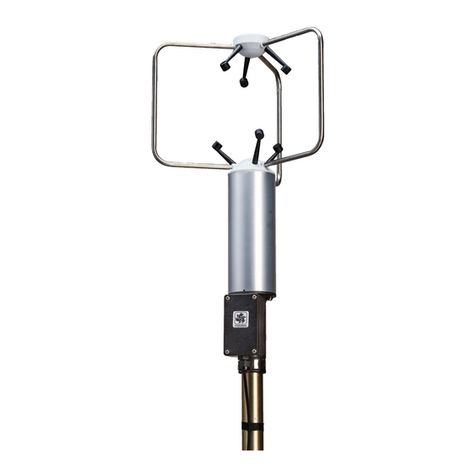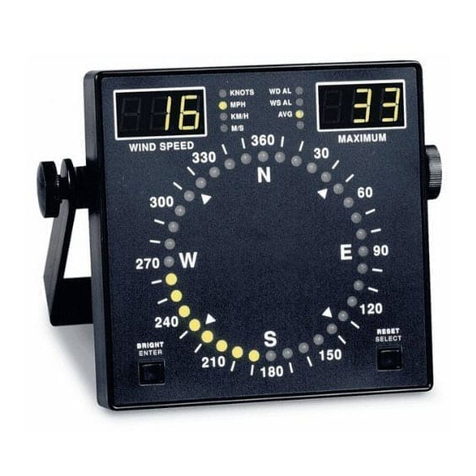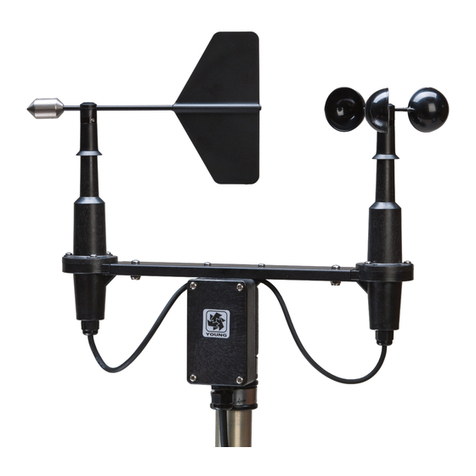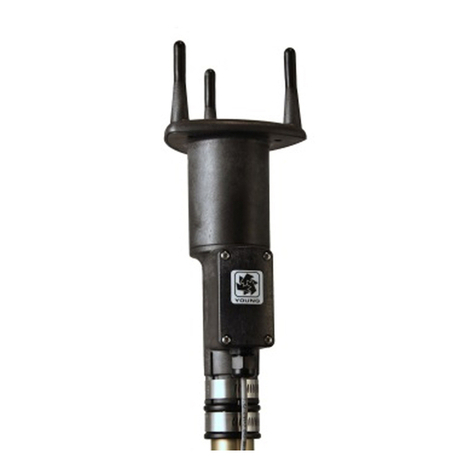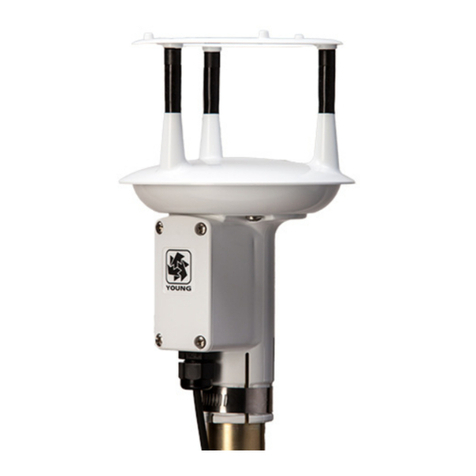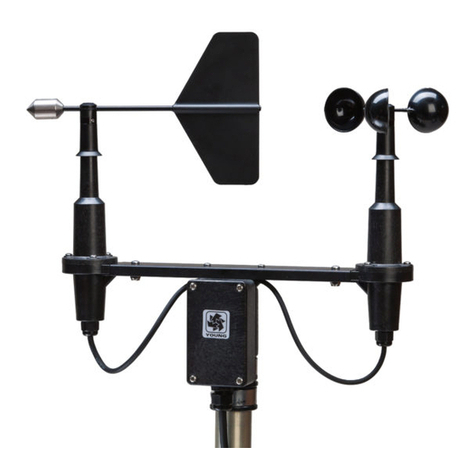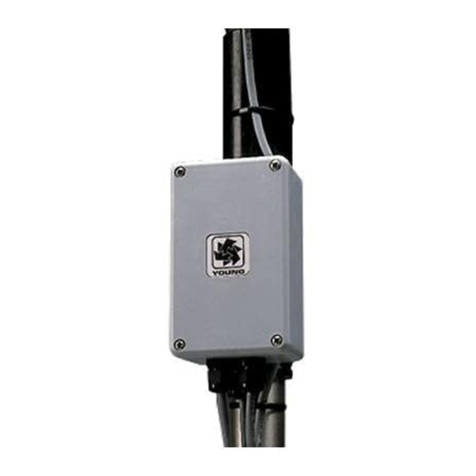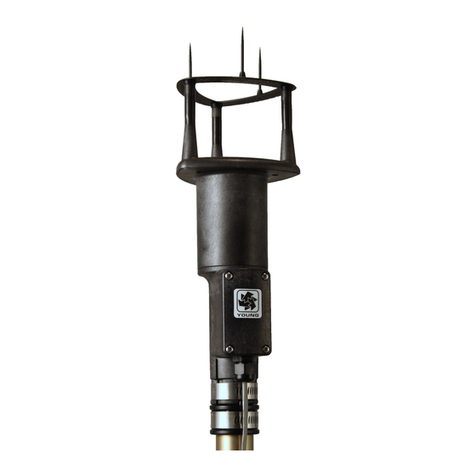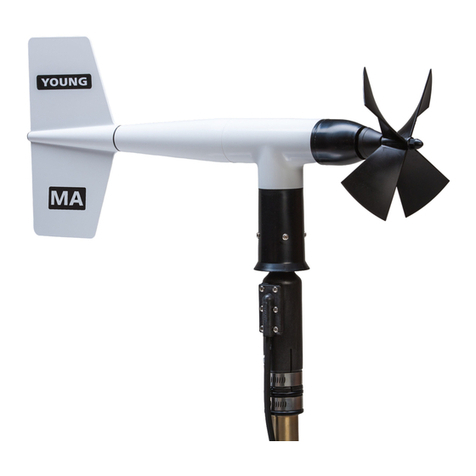
Page 2
05305-90(T)
disturbed to twice the height of the structure upwind, six times the
height downwind, and up to twice the height of the structure above
ground. For some applications it may not be practical or necessary
to meet these requirements.
FAILURE TO PROPERLY GROUND THE WIND MONITOR
MAY RESULT IN ERRONEOUS SIGNALS
OR TRANSDUCER DAMAGE.
Grounding the Wind Monitor is vitally important. Without proper
grounding static electrical charge can build up during certain
atmospheric conditions and discharge through the transducers. This
discharge can potentially cause erroneous signals or transducer
failure. To direct the discharge away from the transducers, the
mounting post assembly in which the transducers are mounted is
made with a special antistatic plastic. Therefore it is very important
that the mounting post be connected to a good earth ground. There
are two ways this may be accomplished. First, the Wind Monitor may
be mounted on a metal pipe which is connected to earth ground.
The mounting pipe should not be painted where the Wind Monitor is
mounted. Towers or masts set in concrete should be connected to
one or more grounding rods. If it is difcult to ground the mounting
post in this manner an alternative method should be used. Inside the
junction box the terminal labeled EARTH GND is internally connected
to the antistatic mounting post. This terminal should be connected to
an earth ground (Refer to wiring diagram).
Initial installation is most easily done with two people; one to adjust
the instrument position and the other to observe the indicating device.
After initial installation, the instrument can be removed and returned
to its mounting without realigning the vane since the orientation ring
preserves the wind direction reference. Install the Wind Monitor
following these steps:
1. MOUNT WIND MONITOR
a) Place orientation ring on mounting post.
Do Not tighten band clamp yet.
b) Place Wind Monitor on mounting post. Do Not tighten band
clamp yet.
2. CONNECT SENSOR CABLE
a) Slide junction box cover up.
b) Route cable thru strain relief opening at bottom of junction box.
Secure cable by tightening packing nut.
c) Connect sensor cable to terminals. See wiring diagram.
d) Slide junction box cover down.
3. ALIGN VANE
a) Connect instrument to an indicator.
b) Choose a known wind direction reference point on the horizon.
c) Sighting down instrument centerline, point nose cone at
reference point on horizon.
d) While holding vane in position, slowly turn base until indicator
shows proper value.
e) Tighten mounting post band clamp.
f) Engage orientation ring indexing pin in notch at instrument
base.
g) Tighten orientation ring band clamp.
CALIBRATION
The Wind Monitor is fully calibrated before shipment and should
require no adjustments. Recalibration may be necessary after some
maintenance operations. Periodic calibration checks are desirable
and may be necessary where the instrument is used in programs
which require auditing of sensor performance.
Accurate wind direction calibration requires a Model 18112 Vane
Angle Bench Stand. Begin by connecting the instrument to a
signal conditioning circuit which has some method of indicating
azimuth value. This may be a display which shows azimuth values
in angular degrees or simply a voltmeter monitoring the output.
Orient the base with the junction box at 180°. Visually align the
vane with the crossmarkings and observe the indicator output. If
the vane position and indicator do not agree within 5°, adjust the
potentiometer coupling inside the main housing. Details for making
this adjustment appear in the MAINTENANCE, potentiometer
replacement outline, step 7.
It is important to note that, while the sensor mechanically
rotates through 360°, the full scale wind direction signal from the
instrument occurs at 355°. The signal conditioning electronics
must be adjusted accordingly. For example, in a circuit where 0
to 1.000 VDC represents 0° to 360°, the output must be adjusted
for 0.986 VDC when the instrument is at 355°. (355°/360° X 1.000
volts = 0.986 volts)
Wind speed calibration is determined by propeller pitch and the
output characteristics of the transducer. Calibration formulas
showing wind speed vs. propeller rpm and output frequency are
included below. Standard accuracy is ± 0.3 m/s (0.6mph). For
greater accuracy, the device must be individually calibrated in
comparison with a wind speed standard. Contact the factory or
your supplier to schedule a NIST (National Institute of Standards
& Technology) traceable wind tunnel calibration in our facility.
To calibrate wind system electronics using a signal from the
instrument, temporarily remove the propeller and connect an
Anemometer Drive (18802 or equivalent) to the propeller shaft.
Apply the appropriate calibration formula to the calibrating motor
rpm and adjust the electronics for the proper value. For example,
with the propeller shaft turning at 3600 rpm, adjust an indicator to
display 18.4 meters per second. (3600 rpm X 0.00512 m/s/rpm =
18.4 m/s).
CALIBRATION FORMULAS
Model 05305 Wind Monitor-AQ w / 08254 Propeller
WIND SPEED vs PROPELLER RPM
m/s = 0.00512 x rpm
knots = 0.00995 x rpm
mph = 0.01145 x rpm
km/h = 0.01843 x rpm
WIND SPEED vs OUTPUT
FREQUENCY
m/s = 0.1024 x Hz
knots = 0.1990 x Hz
mph = 0.2290 x Hz
km/h = 0.3686 x Hz
MAINTENANCE
Given proper care, the Wind Monitor should provide years of service.
The only components likely to need replacement due to normal wear
are the precision ball bearings and the wind direction potentiometer.
Only a qualied instrument technician should perform the replace-
ment. If service facilities are not available, return the instrument to the
company. Refer to the drawings to become familiar with part names
and locations. The asterisk * which appears in the following outlines
is a reminder that maximum torque on all set screws is 80 oz-in.
POTENTIOMETER REPLACEMENT
The potentiometer has a life expectancy of fty million revolutions.
As it becomes worn, the element may begin to produce noisy signals
or become nonlinear. When signal noise or non-linearity becomes
unacceptable, replace the potentiometer. Refer to exploded view
drawing and proceed as follows:

